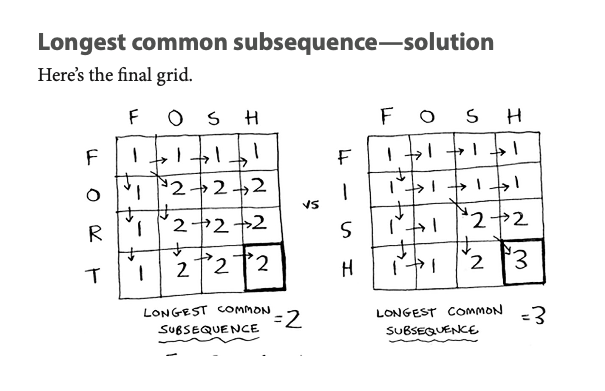- Published on
About Dynamic Programming

DP = Recursion + Memorization
What is DP?
DP is firstly introduced by Richard E. Bellman in 1953. A problem is broken down into sub-problems, the results are saved, and then the sub-problems are optimized to find the overall solution. It often appears with a constraint, when you try to optimize something with a constraint.
About DP
- DP is useful when you're trying to optimize something given a constraint.
- You can use dynamic programming when the problem can be broken into discrete subproblems.
- Every DP involves a
grid. Draw the grid, think about what will be the row and col of this grid? the constraint and the solution? - The values in the cells are usually what you're trying to optimize.
- Each cell is a subproblem, so think about how you can divide your problem into subproblems. What does the value of the cell represent?
Exercises in Hackerrank
The Longest Common Subsequence
Problem link. Here,dp[i][j]represents the length of the longest common subsequences between the firstielements of listaand the firstjelements of listb. The reasoning behind the linedp[i][j] = Math.max(dp[i - 1][j], dp[i][j - 1]);is as follows:- If the last elements of both lists
(a.get(i - 1)andb.get(j - 1))are equal, then we extend the LCS by one, anddp[i][j]is set todp[i - 1][j - 1] + 1. - If the last elements of both lists are not equal, then we need to consider two cases:
- If we exclude the last element of list
a, then the LCS remains the same as the LCS between the first i - 1 elements of list a and the first j elements of list b, i.e.,dp[i][j] = dp[i - 1][j]. - If we exclude the last element of list
b, then the LCS remains the same as the LCS between the first i elements of list a and the first j - 1 elements of list b, i.e.,dp[i][j] = dp[i][j - 1]. So,dp[i][j]is set to the maximum of these two values because we want to find the longest common subsequence. If either of the lists has a longer common subsequence without including the current element(a.get(i - 1) or b.get(j - 1)), we take that value. This ensures thatdp[i][j]contains the length of the longest common subsequence up to the ith element of list a and the jth element of list b.
- If we exclude the last element of list
public static List<Integer> longestCommonSubsequence(List<Integer> a, List<Integer> b){ int m = a.size(); int n = b.size(); int[][] dp = new int[m+1][n+1]; for(int i = 1; i <= m; i++){ for(int j = 1; j <=n; j++){ if(a.get(i-1).equals(b.get(j-1))){ dp[i][j] = dp[i-1][j-1] + 1; } else { dp[i][j] = Math.max(dp[i-1][j], dp[i][j-1]); } } } List<Integer> lcs = new ArrayList<>(); int i = m, j = n; while(i > 0 && j > 0){ if(a.get(i-1).equals(b.get(j-1))){ lcs.add(a.get(i-1)); i--; j--; } else if(dp[i-1][j] > dp[i][j-1]){ i--; } else { j--; } } Collections.reverse(lcs); return lcs; }- If the last elements of both lists
The Maximum Contiguous Subarray
Problem link. Kandane's algorithm. O(n) time, O(1) space.def max_subarray(numbers): """Find the largest sum of any contiguous subarray.""" best_sum = - infinity current_sum = 0 for x in numbers: current_sum = max(x, current_sum + x) best_sum = max(best_sum, current_sum) return best_sumpublic static List<Integer> maxSubarray(List<Integer> arr) { int currentSum = arr.get(0); int maxSum = arr.get(0); for (int i = 1; i < arr.size(); i++) { int num = arr.get(i); currentSum = Math.max(num, currentSum + num); maxSum = Math.max(maxSum, currentSum); } List<Integer> res = new ArrayList<>(); res.add(maxSum); Collections.sort(arr); Collections.reverse(arr); int sum = arr.get(0); for(int i = 1;i<arr.size();i++){ sum = Math.max(sum, sum+arr.get(i)); } res.add(sum); return res; //return the maximum subarray and subsequence sums }